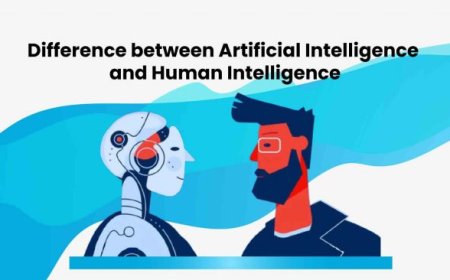Major Domains of Artificial Intelligence (AI)
The major domains of AI, including machine learning, natural language processing, robotics, and deep learning, and their impact on industries and daily life.

Based on my observations, modern technology provides far more than what we often envision from science fiction movies. For instance, when I worked with a healthcare provider, I was astounded by how rapidly it could identify health trends, assisting physicians in generating quicker, more intelligent diagnoses and improving everyday life and decision-making.
I can tell you that there is more than one tool in current technology since I am passionate about it. Instead, it consists of several fields, each with unique characteristics, such as assisting computers in learning patterns or comprehending language, which eventually shapes industries and enhances daily lives.
Modern technology, including its specific applications such as image recognition for medical purposes or learning from data for forecasts, is valued by many leaders in a variety of industries. Understanding these areas helps it feel more approachable, even if it may appear complex. It reveals methods that benefit industries and daily lives.
What is Artificial Intelligence (AI)?
Artificial Intelligence, or AI, is a type of technology that allows computers and machines to perform tasks that typically require human intelligence. Understanding language, identifying pictures, making judgments, and even learning from mistakes are some examples of these skills. AI enables robots to solve issues and perform tasks in ways that are similar to human thought and behavior.
For example, Artificial Intelligence enables voice assistants like Siri and Alexa to comprehend what you say and provide insightful responses. Alternatively, Netflix uses artificial intelligence (AI) to identify movies that you might enjoy based on your previous selections.
AI improves without specialized programming by using data to identify trends. It is used in a variety of fields, including entertainment and healthcare, to simplify and expedite daily chores.
The Relevance of AI is Growing in Modern Society
-
Healthcare Improvements: With the use of technology, physicians can evaluate medical data more rapidly, resulting in quicker, more precise diagnoses and individualized treatment regimens.
-
Enhanced Customer Experience: Technology is used by businesses to customize shopping, provide product recommendations, and provide 24/7 customer service through friendly, supportive chat agents.
-
Education Personalization: Customized learning is made possible by technology, which allows students to study at their own speed and maintain more interest in their academic path.
-
Environmental Research: Technology is used by researchers to evaluate climate data, forecast changes, and identify solutions to environmental problems and safeguard the earth.
-
Smart Homes and Cities: A few instances of how Domains of Artificial Intelligence (AI) save energy costs, enhance home ease, and enable more intelligent urban planning include voice assistants and automated lighting.
-
Business and Market Insights: Businesses may better identify trends, make better decisions, increase productivity, and anticipate future client needs with the use of technology.
The Benefits and Challenges of Artificial Intelligence
Benefits of Artificial Intelligence
1. Accelerated Innovation
Researchers may find new answers more rapidly with the use of machine learning and predictive models, which accelerates progress in disciplines like engineering, environmental science, and medicine.
2. Enhanced Problem Solving
Deep learning enables systems to manage large volumes of data and intricate computations, offering answers that would be too much for people to handle alone.
3. Boosted Creativity
AI tools, like generative models, provide inspiration for creative industries like music, painting, and design. They also improve creative processes and give new viewpoints.
4. Resource Optimization
AI optimizes resource utilization through data analytics in industries like energy and agriculture, assisting in waste reduction and sustainability promotion.
5. Enhanced Accessibility
The knowledge of Certified Machine Learning Professionals guarantees that natural language processing techniques like text-to-speech and voice recognition successfully encourage inclusion by enhancing technological accessibility for people with disabilities.
6. Real-Time Decision Making
AI enables speedy analysis and decision-making in fields like emergency response and financial forecasts, facilitating prompt reactions to shifting circumstances.
Challenges of Artificial Intelligence
1. Job Displacement
Certain jobs may be replaced by automation, raising unemployment worries and necessitating the acquisition of new skills for developing technological tasks.
2. Privacy Concerns
AI data collecting raises concerns about data abuse and protection as it may jeopardize personal privacy if information is not properly handled or protected.
AI may inadvertently mirror data biases, leading to incorrect conclusions, especially in delicate domains like loan approvals and employment screening.
4. High Development Costs
Because AI systems may be expensive to develop and operate, smaller companies may find it more difficult to adopt these technologies and remain competitive.
5. Security Risks
Artificial intelligence (AI) is susceptible to cyberattacks, thus regular security updates are required to shield private data from abuse or illegal access.
6. Lack of Transparency
Because certain AI procedures are complicated, consumers may find it difficult to comprehend the decision-making process, which might erode their confidence in the technology's results.
Exploring the Major Domains of AI
1. Machine Learning (ML)
What is Machine Learning?
Computers can learn from data by identifying patterns according to machine learning, just like a dog learns to retrieve through experience. Instead of always following instructions, computers get better over time and start making more intelligent choices depending on what they see.
Why is it Important?
Many of the things we use daily, such as search engines and streaming platforms' recommendation algorithms, are powered by machine learning. It's the AI component that enables your favorite music app to recommend songs you might enjoy or assists in identifying spam in emails.
How Does it Work?
As a fundamental component of the Domains of AI, machine learning relies on providing computers with large amounts of data so they may see patterns and make choices. It encompasses models such as reinforcement learning, in which appropriate behavior is rewarded, and supervised learning with labeled data.
2. Natural Language Processing (NLP)
What is Natural Language Processing?
Natural Language Processing, or NLP, is the part of AI that helps computers understand human language. It’s the reason why we can talk to virtual assistants like Siri or Alexa and get answers back.
Why is it Important?
NLP is crucial because it enables natural-feeling computer-human communication. NLP allows you to ask your phone for directions, submit a query to a search engine, and even employ translation software to comprehend different languages.
How Does it Work?
By breaking down phrases into manageable sections, Natural Language Processing, one of the Domains of AI, helps computers understand language. This is difficult since words frequently have more than one meaning, and grammar can be erratic. It comes with features like phrase creation and sentiment analysis for crafting answers.

3. Computer Vision
What is Computer Vision?
Computer vision is the branch of artificial intelligence that enables computers to "see" and comprehend pictures and movies. This area enables AI to identify individuals, objects, and even intricate sceneries in images or movies.
Why is it Important?
Consider applications that can recognize plants based just on a photo or self-driving automobiles. Computer vision is the engine that powers them. It is also utilized in the medical field, where computers assist physicians in identifying illnesses in MRIs or X-rays.
How Does it Work?
By dividing pictures into smaller components, like pixels, computer vision—a crucial component of the Domains of AI—assists computers in comprehending visuals and identifying patterns. For instance, the system recognizes a dog by its fur, eyes, and nose.
4. Robotics
What is Robotics?
The field of AI that blends "intelligence" with physical machinery is called robotics. It is the area that enables robots to interact with the outside world and comprehend their environment.
Why is it Important?
Many industries greatly benefit from the use of robots. They can assist with medical procedures, operate in hazardous settings, or even assist with household chores. Robots can learn and become more proficient at tasks thanks to robotics, which blends AI and engineering.
How Does it Work?
Robotics, one of the Domains of AI, collects environmental data via sensors, enabling intelligent decision-making. For example, a robot vacuum recognizes furniture and walls to steer clear of them and determines the optimal cleaning route. Even sophisticated robots can adjust to novel circumstances.

5. Expert Systems
What is an Expert System?
Expert systems are made to simulate how people make decisions. They are employed to assist individuals in making difficult judgments in specialist domains such as finance or medical.
Why is it Important?
Expert systems enable computers to carry out activities like financial trend prediction and illness diagnosis that would typically need a great deal of expertise and knowledge.
How Does it Work?
The Domains of AI include expert systems, which are based on a large body of information and predetermined rules. Similar to seeking knowledgeable counsel or assistance from an expert, they use these criteria to provide responses or ideas when a topic is posed.
6. Deep Learning
What is Deep Learning?
Deep Learning is a more advanced subfield of machine learning that looks for patterns in data using "neural networks." Many recent advances in AI are powered by it.
Why is it Important?
Deep Learning makes it possible for computers to comprehend conversations, identify faces, and even produce art. Voice recognition and translation apps are only two examples of the many AI applications that are used nowadays.
How Does it Work?
Within the Domains of AI, deep learning is a field that uses layers to process data, much like a cake. Every layer helps in the system's comprehension of progressively intricate patterns. As the name suggests, the more layers, the "deeper" the insights.
7. Speech Recognition
What is Speech Recognition?
The area of artificial intelligence that makes it possible for computers to comprehend spoken language is called speech recognition. Voice-controlled gadgets are made possible by their ability to translate spoken words into text or actions.
Why is it Important?
One of the main features of hands-free technology is speech recognition, which makes using gadgets without typing simpler. It is utilized in programs such as automated customer support, dictation software, and virtual assistants.
How Does it Work?
Domains of AI include speech recognition, which examines sound waves to find patterns and associate them with words. Even when taking different accents and speech patterns into consideration, it is still able to effectively detect words since it breaks speech down into smaller phonetic components.
8. Sentiment Analysis
What is Sentiment Analysis?
Sentiment analysis is an aspect of artificial intelligence that analyzes and categorizes the emotional content of text. In social media postings, reviews, and customer feedback, it's frequently used to measure attitudes or opinions.
Why is it Important?
Businesses may enhance their goods and services by knowing the feelings of their customers. Organizations may respond to concerns or take advantage of favorable comments by using sentiment analysis to get insight into public opinion.
How Does it Work?
Sentiment analysis breaks down text by detecting words and phrases that express emotions using natural language processing. It helps businesses determine how people feel about their brand or product by categorizing these as neutral, negative, or positive.
The Future of AI: Emerging Trends and Technologies
I have seen how technology has advanced in the last several years, bringing with it new concepts that influence our day-to-day existence. The emphasis on making technology more accessible and individualized is a trend I've seen. These innovations genuinely improve life's convenience and connectivity, from smarter household appliances to effective medical equipment.
Natural language understanding, which improves the ease and intuitiveness of our interactions with technology, is one intriguing topic that is gaining traction within the domains of AI. These technologies are essential for growth, according to experts in a variety of industries, particularly in the fields of healthcare, finance, and education. Though it might be intimidating, new technology is meant to make our lives easier, improving everything from everyday comforts to medical treatment.
Technology's quick development demonstrates how much it can improve our daily lives, jobs, and health. The domains of AI deliver a variety of useful tools that transform sectors and simplify difficult processes, from customized suggestions to real-time decision-making. We can better comprehend the influence of AI on everything from smart homes to medical developments by investigating the domains of AI such as language processing, robotics, and deep learning. More inventions that make life easier, link us, and enhance our quality of life are expected to emerge as the domains of AI continue to advance.






























































